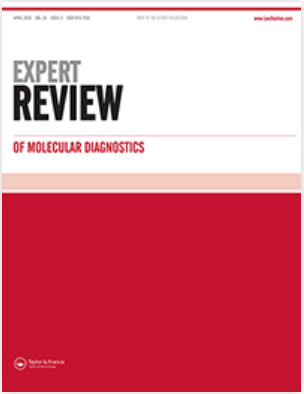帕金森病液体生物标志物的研究进展。
IF 3.6
3区 医学
Q1 PATHOLOGY
引用次数: 0
摘要
简介帕金森病(PD)的诊断标准依赖于临床特征,主要是运动特征,这意味着运动前期无法准确识别。为了实现可靠的早期诊断,与阿尔茨海默病(AD)的诊断方法类似,帕金森病的诊断正在从临床诊断向生物学诊断转变。这种转变从脑脊液(CSF)生物标志物的研究中获益匪浅,因为它们反映了帕金森病正在发生的分子致病机制,从而在临床表现方面及时发现疾病。反映 AD 病理学和轴突损伤的 CSF 生物标记物(神经丝蛋白轻链)和多巴胺能功能障碍的新型标记物(DOPA 脱羧酶)为 PD 的神经化学特征描述增加了有价值的诊断和预后信息。这种方法可以为目前正在研究的疾病改变治疗提供最佳方案。本文章由计算机程序翻译,如有差异,请以英文原文为准。
Research advancement in fluid biomarkers for Parkinson's disease.
INTRODUCTION
Diagnostic criteria for Parkinson's disease (PD) rely on clinical, mainly motor, features, implying that pre-motor phase cannot be accurately identified. To achieve a reliable early diagnosis, similar to what has been done for Alzheimer's disease (AD), a shift from clinical to biological identification of PD is being pursued. This shift has taken great advantage from the research on cerebrospinal fluid (CSF) biomarkers as they mirror the ongoing molecular pathogenic mechanisms taking place in PD, thus intercepting the disease timely with respect to clinical manifestations.
AREAS COVERED
CSF α-synuclein seed amplification assay (αS-SAA) has emerged as the most promising biomarker of α-synucleinopathy. CSF biomarkers reflecting AD-pathology and axonal damage (neurofilament light chain) and a novel marker of dopaminergic dysfunction (DOPA decarboxylase) add valuable diagnostic and prognostic information in the neurochemical characterization of PD.
EXPERT OPINION
A biological classification system of PD, encompassing pathophysiological and staging biomarkers, might ensure both early identification and prognostic characterization of the patient. This approach could allow for the best setting for disease-modifying treatments which are currently under investigation.
求助全文
通过发布文献求助,成功后即可免费获取论文全文。
去求助
来源期刊
CiteScore
6.60
自引率
0.00%
发文量
71
审稿时长
1 months
期刊介绍:
Expert Review of Molecular Diagnostics (ISSN 1473-7159) publishes expert reviews of the latest advancements in the field of molecular diagnostics including the detection and monitoring of the molecular causes of disease that are being translated into groundbreaking diagnostic and prognostic technologies to be used in the clinical diagnostic setting.
Each issue of Expert Review of Molecular Diagnostics contains leading reviews on current and emerging topics relating to molecular diagnostics, subject to a rigorous peer review process; editorials discussing contentious issues in the field; diagnostic profiles featuring independent, expert evaluations of diagnostic tests; meeting reports of recent molecular diagnostics conferences and key paper evaluations featuring assessments of significant, recently published articles from specialists in molecular diagnostic therapy.
Expert Review of Molecular Diagnostics provides the forum for reporting the critical advances being made in this ever-expanding field, as well as the major challenges ahead in their clinical implementation. The journal delivers this information in concise, at-a-glance article formats: invaluable to a time-constrained community.

 求助内容:
求助内容: 应助结果提醒方式:
应助结果提醒方式:


